
Song Seok Shin, PhD, Director of Life Science R&D Center at SKbioland, one of top players of natural active cosmetic ingredient business in Korea. Ph.D in Chemistry from Seoul National University in Korea and professional experiences for 19 years in drug discovery and beauty research at Amore pacific R&D Center, the global Korean beauty company, serving as the Vice President of Beauty Food Research Institute of the company from 2015 to 2016.
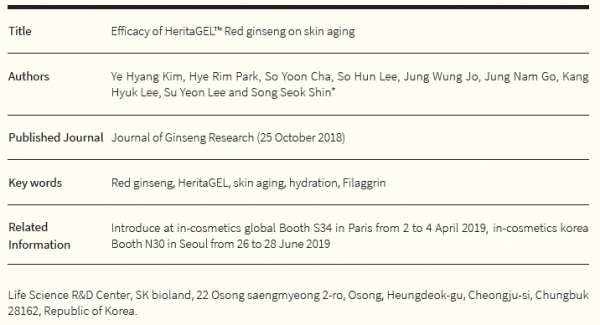
ABSTRACT
In aged skin, degradation of collagen fibers, which occupy the majority of the extracellular matrix in the dermis, and changes of skin constituents, such as hyaluronic acid and ceramide, cause wrinkles and decrease skin moisturization to contribute to dryness and lower elasticity skin. Red ginsengRG is used as a cosmetic and food material and is known to protect from UVB-induced cell death, increase skin hydration, prevent wrinkles, and have an anti-oxidative effect. But, in general, RG used as a material is the soluble liquid portion in the solvent, and the part that is not soluble in the solvent is discarded. Thus, we made the whole RG into microgranulation and dispersed in water to produce gel form for using entire RG, and it was named HeritaGEL™ Red ginseng. This paper will discuss HeritaGEL™ Red ginseng as an effective ingredient for anti-aging cosmetics.
In aged skin, degradation of collagen fibers, which occupy the majority of the extracellular matrix in the dermis, and changes of skin constituents, such as hyaluronic acid and ceramide, cause wrinkles and decrease skin moisturization to contribute to dryness and lower elasticity skin. RG is used as a cosmetic and food material and is known to protect from UVB-induced cell death, increase skin hydration, prevent wrinkles, and have an anti-oxidative effect. But, in general, RG used as a material is the soluble liquid portion in the solvent, and the part that is not soluble in the solvent is discarded. Thus, we made the whole RG into microgranulation and dispersed in water to produce gel form for using entire RG, and it was named HeritaGEL™ Red ginseng. This paper will discuss HeritaGEL™ Red ginseng as an effective ingredient for anti-aging cosmetics.
INTRODUCTION
Ⅰ Skin aging and dryness
Skin aging is a complex process that is caused by several factors. There are two main processes of cutaneous aging: intrinsic (or innate) and extrinsic aging. Intrinsic aging occurs by random cell damage during metabolic processes and depends on time. Extrinsic aging is caused by environmental stimuli, UV, air pollution, temperature, smoking, etc. (1). In the aged skin, the number of dermis and epidermis cells may reduce, and the cells become less functional, resulting in wrinkle formation, pigmentation, dryness, thick skin, and decreased elasticity (2). The exposure to UV light induces the production of Matrix metalloproteinasesMMPs in human skin. MMPs are responsible for the degradation of the Extracellular matrixECM proteins such as collagen, elastin, and proteoglycans (2, 3). Among them, MMP-1, as a collagenase, degrades Type I collagenCOL1A1, the main form in human skin, and Type III collagen (3-5). It was reported that collagen synthesis is reduced in naturally aged skin and photoaged skin. Also, this reduction in collagen synthesis with increasing age was caused by the increased MMPs level (6-8). As mentioned earlier, the skin wrinkles as well as dries when it ages, and the Stratum corneumSC plays a role in maintaining skin moisture. In the SC, lipids, such as Ceramide CER, cholestero, and free fatty acids, are responsible for the formation of the skin barrier and the prevention of trans-epidermal water loss. Especially, CER constitutes about 50% of intercellular SC lipids and is generally produced by the de novo pathway, one of which is initiated by serine palmitoyl transferaseSPT (9, 10). And, it is known that amino acids and derivatives produced by FilaggrinFLG processing are the contributors to the Natural moisturizing factorsNMFs. NMFs maintain skin hydration and retain water (11, 12).
Ⅱ Red Ginseng
Panax ginseng is a perennial herb that belongs to the Araliaceae family and the genus Panax and has been widely used as a medicinal herb as it has many benefits. RG is a red brown ginseng made by steaming and drying for a long time (13). It was reported that RG ethanol extracts increased collagen synthesis and inhibited MMP-1 activity (14). Ginsenoside F1 protects human keratinocytes from UVB-induced apoptosis, compound K increases the level of Hyaluronan synthetase 2HAS2 in human keratinocytes, and 0.5% RG extract improves skin hydration by accumulating CER and increasing the expression of SPT in UVirradiated hairless mice (15-17). Also, RG residue extracts showed anti-oxidative effect and inhibited elastase activity (13). When manufactured as a product, RG is extracted or concentrated using a solvent such as water or ethanol and is used as a powder or beverage according to the type of product required (18). In this way, only the soluble portion of RG is used, and the non-soluble fiber part is discarded which then becomes an environmental pollution source (19). However, these discarded RG also had antioxidant and anti-wrinkle effects and increased immunity when used in chicken feed (13,19). Therefore, we made the entire RG into gel form to use whole RG, including both the soluble and non-soluble RG portions. In the present study, we investigated the potential of HeritaGEL™ Red ginseng as an anti-aging ingredient for skin care.
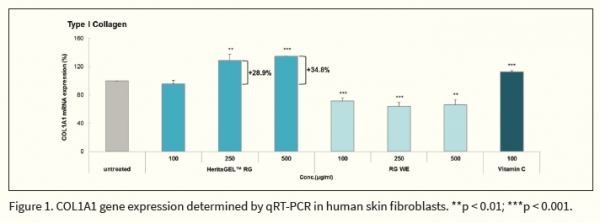
RESULTS AND DISCUSSION
HeritaGEL™ Red ginseng induces the production of Type I collagen mRNA Collagen is a major constituent of connective tissue, and COL1A1 is the main form in human skin (5). And, RG ethanol extract induced the
synthesis of collagen and suppressed MMP-1 activity, but not water extract (14). In our study, Red Ginseng Water-extractRG WE did not increase COL1A1 mRNA expression, but the group treated with HeritaGEL™ RG induced COL1A1 expression as compared with the untreated group (Figure 1).
HeritaGEL™ Red ginseng modulates the expression and activity of MMPs MMP-1 is a typical collagenase-degrading collagen, and MMP-2 and MMP-9 are gelatinases that digest Type I and IV collagen. These MMPs contribute for wrinkle formation and reduction of skin elasticity (3). As shown in Figure 2A, after treatment with HeritaGEL™ RG, MMP-1, 2, 9 mRNA levels were decreased by approximately 43.7%, 30.3%, and 25.1%, respectively. RG WE reduced MMP-1, 2 levels by about 16.6% and 29.9%, and decreased MMP-9 only at 500 μg/ml. And, HeritaGEL™ RG significantly suppressed the activity of MMP-2 and MMP-9. After treatment with RG WE, MMP-2 activity was inhibited only at 500 μg/ml, and the activity of MMP-9 was not inhibited (Figure 2B, C). HeritaGEL™ Red ginseng upregulates the levels of skin hydration-related factors Changes in skin water content and barrier function occur as the skin ages. Aquaporin 3AQP3 is responsible for allowing water, glycerol, and others to pass through the membrane. It was known that decrease of AQP3 causes skin dryness and reduction of skin elasticity (20,21). HA, a component of the ECM, is important for skin hydration and is synthesized by a specific enzyme called HAS. Among three HASs, HAS2 is a major isoform producing HA in skin (22). In the SC, CER, cholesterol, and free fatty acids are responsible for the prevention of water loss. CER is generally produced through the de novo pathway, one of which is initiated by SPT (10). And, pro-FLG is processed to FLG repeat units, and FLG is degraded into free amino acids, which contribute to formation of the NMFs that retain water content on the skin (11). HeritaGEL™ RG significantly increased the levels of AQP3 and FLG by 145.4% and 134%, respectively, in a dose-dependent manner. And the mRNA levels of SPT and HAS2 were upregulated by HeritaGEL™ RG compared with RG WE (Figure 3A). The protein expressions are shown in panel B and C in Figure 3. After treatment with HeritaGEL™ RG, CERS3 was effectively increased by more than two times than untreated group and FLG protein level rose by 169.4%. RG WE induced CERS3 by 154.2%. High-performance liquid chromatographyHPLC analysis of RG NGEL and RG WE To investigate ginsenosides, the main components of RG, contained in RG WE and HeritaGEL™ RG, we performed HPLC analysis. Accurate analysis of these two substances was performed by comparing the HPLC peak with standard materials of ginsenoside Rg1, Re, Rb1, Rh1-S, and Rh1-R (Sigma-Aldrich). In the HeritaGEL™ RG analysis, no peak was found. RG WE contained 1.13% of Rg1, 1.28% of Re, 2.89% of Rb1, 0.94% of Rh1-S, and 0.46% of Rh1-R. Clinical study on Anti-wrinkle effect of HeritaGEL™ Red ginseng Clinical study conducted the test according to the guidelines for the application and testing of cosmetics by the Korea Food & Drug Administration, as well as the regulations set by Seowon Skin Research Center. For anti-wrinkle testing, 20 subjects applied cream containing HeratGEL™ RG to the face twice a day for four weeks and measured skin changes before and after product application. The results showed that the measurement of the Overall size, Depth, and Max_Depth decreased statistically significantly to 21.2%, 21.9% and 21.6%, respectively, in the four weeks following use compared to pre-use (Fig. 4). Thus, HeritaGEL™ RG has an effect on improving wrinkles.
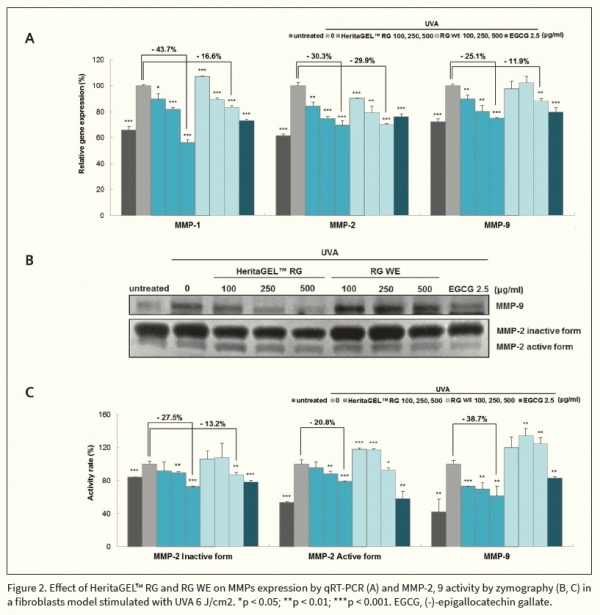
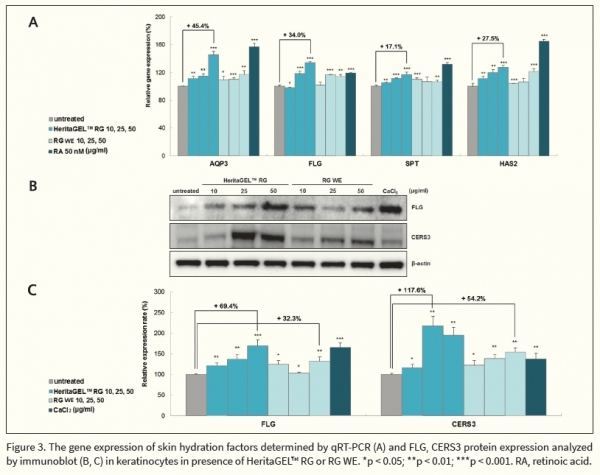
CONCLUSION
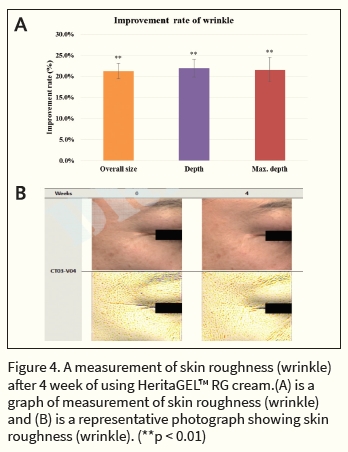
Our results showed that HeritaGEL™ Red GinsengHeritaGEL™ RG can prevent the wrinkle formation by increasing COL1A1 and suppression of MMPs expression or activity to cause collagen or elastin degradation. And, further HeritaGEL™ RG promoted the expression of FLG, CERS3 and others, which are important for skin moisturization, thereby enhancing skin barrier and preventing water loss compared with Red Ginseng Waterextract RG WE.
In addition, the anti-wrinkle effect of HeritaGEL™ RG was demonstrated through clinical trials. Finally, all these data supports that HeritaGEL™ RG can effectively delay skin aging and further protect the environment.
REFERENCES
1. Farage MA, Miller KW, Elsner P, Maibach HI. Int. J. Cosmet. Sci, 30(2), 87-95 (2008).
2. Pandel R, Poljšak B, Godic A, Dahmane R. ISRN Dermatol, 2013, 1-11 (2013).
3. Pittayapruek P, Meephansan J, Prapapan O, Komine M, Ohtsuki M. Int. J. Mol. Sci, 17(6), E868 (2016).
4. Rabe JH1, Mamelak AJ, McElgunn PJ, Morison WL, Sauder DN. J. Am. Acad. Dermatol, 55(1),1-19 (2006).
5. Gelse K1, Pöschl E, Aigner T. Adv. Drug. Deliv. Rev, 55(12), 1531-46 (2003).
6. Fisher GJ, Datta SC, Talwar HS, Wang ZQ, Varani J, Kang S, Voorhees JJ. Nature, 379(6563), 335-8 (1996).
7. Fisher GJ, Wang Z-Q, Datta SC, Varani J, Kang S, Voorhees JJ. N. Engl. J. Med, 337(20), 1419-28 (1997).
8. Varani J, Warner RL, Gharaee-Kermani M, Phan SH, Kang S, Chung JH, Wang ZQ, Datta SC, Fisher GJ, Voorhees JJ. J. Invest. Dermatol, 114(3), 480-6 (2000).
9. Borodzicz S, Rudnicka L, Mirowska-Guzel D, Cudnoch-Jedrzejewska A. Lipids Health Dis, 15, 1-9 (2016).
10. Cha HJ, He C, Zhao H, Dong Y, An IS, An S. Int. J. Mol. Med, 38(1), 16-22 (2016).
11. Hoste E, Kemperman P, Devos M, Denecker G, Kezic S, Yau N, Gilbert B, Lippens S, De Groote P, Roelandt R, et al. Caspase-14 is required for filaggrin degradation to natural moisturizing factors in the skin. J. Invest. Dermatol,131(11), 2233-41 (2011).
12. Sandilands A, Sutherland C, Irvine AD, McLean WH. J. Cell Sci, 122(Pt 9), 1285-94 (2009).
13. Lee MY, Kim BA, Yang JC. J. Kor. Oil Chem. Soc, 33(4), 658-66 (2016).
14. Kim N, Koo B, Lee S, Hwang E, So S, Do J. J. Ginseng Res, 31(2), 86-92 (2007).
15. Lee EH, Cho SY, Kim SJ, Shin ES, Chang HK, Kim DH, Yeom MH, Woe KS, Lee J, Sim YC, et al. J. Invest. Dermatol, 121(3), 607-13 (2003).
16. Kim S, Kang BY, Cho SY, Sung DS, Chang HK, Yeom MH, Kim DH, Sim YC, Lee YS. Biochem. Biophys. Res. Commun, 316(2), 348-55 (2004).
17. Kim H, Oh I, Park KH, Kim NM, Do JH, Cho Y. J. Med. Food, 12(4), 746-54 (2009).
18. Sung HS, Yoon SK, Kim WJ, Yang CB. Korean J. Ginseng Res, 9(2), 170-8 (1985).
19. Choi JH, Kim CM, Choi IH. J. Environmental Science International, 24(9), 1233-7 (2015).
20. Li J, Tang H, Hu X, Chen M, Xie H. Australas. J. Dermatol, 51(2), 106-12 (2010).
21. Hara M, Verkman AS. Proc. Natl. Acad. Sci. U S A, 100(2), 7360-5 (2003).
22. Papakonstantinou E, Roth M, Karakiulakis G. Dermatoendocrinol, 4(3), 253-8 (2012).

